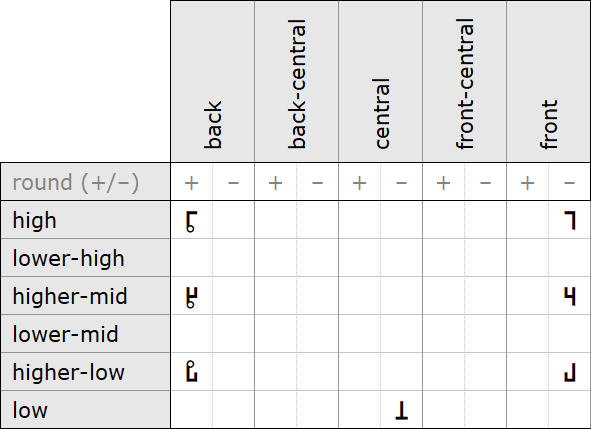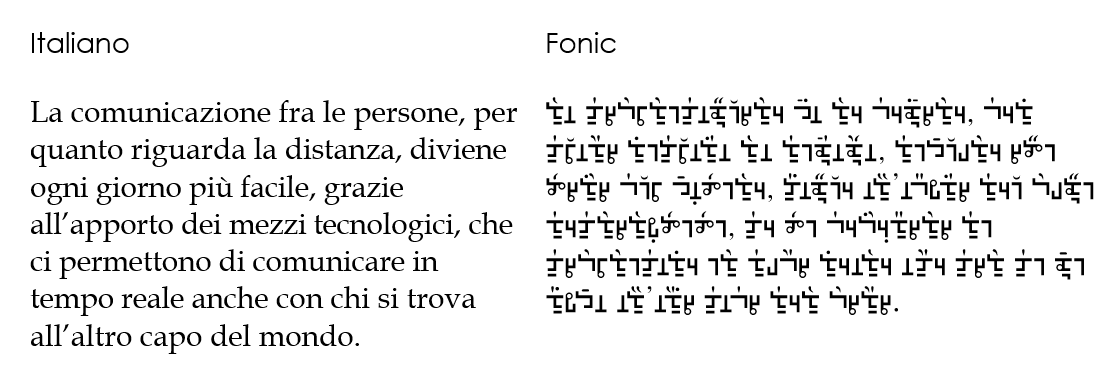Fonic for Italian
Fonic is a phonetic alphabet with a phonoanalogic and phonosymbolic structure, which can be used both in the academic sphere, for the precise phonetic transcription of the pronunciation of all languages, and as an alternative writing system to the current national alphabets. The Fonic alphabet was conceived in 1991 by Andrea Vaccari, who completed its realization in 2018. Version 2.0 was then released in February 2021. The history, development and structure of the Fonic alphabet are illustrated in detail in the book Fonic - Un alfabeto fonoanalogico e fonosimbolico[1]. This page briefly illustrates the Fonic for Italian.
Symbols
With regard to terminology, we prefer to use here the terms contoids and vocoids, instead of consonants and vowels, because they are more exact from the articulatory point of view, as some contoids can assume vowel function in certain contexts, such as the contoid [l] in the English word table [ˈtʰeɪbl̩]. In practice the terms contoids and vocoids refer to the articulatory characteristic of the phones, while consonants and vowels to their practical realization in a certain context.
Contoids
The contoidal system of Italian is rather simple compared to those of other languages, although scholars do not all agree on the exact place of articulatory of some contoids in the standard language, especially those articulated in the area that extends from the alveoli of the teeth to the soft palate, because these contoids can be articulated in slightly different places by native speakers. Anyway, whatever type of contoids we could find in standard Italian, the Fonic alphabet should be able to accurately represent the place of articulation of any of them. So if we believe, for example, that in Italian the contour [t] is alveolar, we can use the alveolar graph, while if we think it is dental, we will use the dental graph. In the following table we have chosen to refer to the current IPA coding, therefore considering it alveolar. The columns of the laringeal, pharyngeal, uvular, alveopalatal and postalveolar phones have been omitted, as they are not present in Italian, and instead the columns for velar-rounded and alveopalatal-rounded phones have been added, because they are not present in the general table of cointoidal symbols of the IPA. Considering the contoids [d, t, z, s, ʣ, ʦ] alveolar, as in the IPA table, the dental column has been also omitted. Likewise, all the lines containing phones that are not presen in the Italian language have been omitted:

Contoids of Italian (Fonic 2.0)
|
Vocoids
The Italian vocoidal system, like the contoidal one, is quite simple, when compared with those of other languages, although scholars do not all agree with regard to the precise articulation of the vocoids. In Italian there are seven vocoids, three of which are articulated in a anterior, three posterior and one central. The anterior ones are [i] of mira [ˈmiˑra], [e] of pera [ˈpeˑra] and [ɛ] of letto[ˈlɛtːo], the posterior ones are [u] of puro [ˈpuˑro], [o] of solo [ˈsoˑlo] and [ɔ] of oca [ˈɔˑka] and the central one is [a] of alba [ˈalba].

Vocoids of Italian (Fonic 2.0)
|
Punctuation, vowel length and accents
For the subdivision of text into words, phrases, sentences and periods, the traditional criteria of common writing are used, that is, a greater space between word and word than between graph and graph of the same word and the normal punctuation marks to separate phrases, sentences and periods. Regarding the phone length, we can distinguish vocoids in short, normal, long, very long, for which we use the same traits of the Latin alphabet with a bow on the short vocoids and a dash on the long ones. For very long ones we use a double dash. The accent is phonetically realized in a different manner for each language, with the use of some phonetic characters, usually length, volume and height of the accented vowel. These parameters can all be present with the same importance, or some may be less important than others or even be absent. In some languages there are even two word accents, one primary and one secondary. To represent the accent by a phonoanalogical symbol, we should therefore write all the phonetic parameters that compose it, but to simplify the writing, we can use a single symbol, as does the IPA, which in Fonic consists of a simple point to be placed under the accented vowel, when using Fonic for the current writing, or alternatively, when using Fonic for precise phonetic transcription, the symbols of the IPA can also be used.
Considerations
Fonic has been conceived as a phonetic alphabet, that could accurately and efficiently transcribe any phonic production and therefore any linguistic statement of any language in the world. But thanks to special precautions and conventions, it is also possible to use it in place of traditional alphabets for everyday writing. There are therefore several options for simplifying the basic writing, which can be achieved mostly through implosions of sequences of graphs in a single graph that retains the distinctive features of the individual phones represented by the graphs. However, we do not speak here about the possible types of implosion, because their description is quite complex.
Example of an italian text in Fonic
We see below the first paragraph of the chapter "Introduction" of the book Fonic - Un alfabeto fonoanalogico e fonosimbolico[1], entitled "Communication and language", transcribed in the ordinary variant of Fonic 2.0.

Example of an italian text in Fonic 2.0
|
Notes
- ^ Andrea Vaccari, Fonic - Un alfabeto fonoanalogico e fonosimbolico, Amazon Publishing, 2018, ISBN 9781730703010.
Bibliography
- Andrea Vaccari, Fonic - Un alfabeto fonoanalogico e fonosimbolico, Amazon Publishing, 2018, ISBN 9781730703010.
- Andrea Vaccari, Imparare il Fonic - Passo dopo passo e una lettera alla volta, Amazon Publishing, 2019, ISBN 9781094954707.